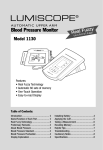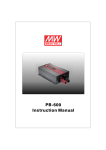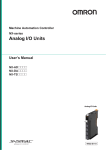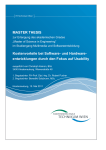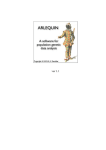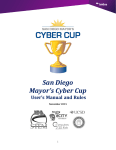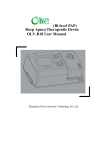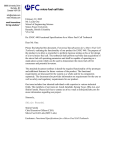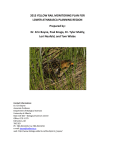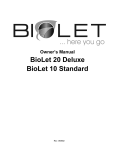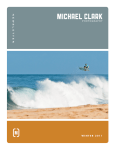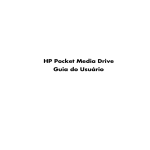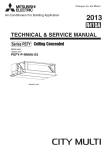Download 981677 The Fuzzy Inference System Translator (FIST) and
Transcript
SAE TECHNICAL PAPER SERIES 981677 The Fuzzy Inference System Translator (FIST) and Micro-Controller Regulation of Plant Growth Chamber Temperature and Humidity Bill Taylor, Elena Leyderman, James Vredenburg, Andrés Estrada and Janell Kueffer New Mexico Highlands University Anthony Maestas Hughes Aircraft 28th International Conference on Environmental Systems Danvers, Massachusetts July 13-16, 1998 400 Commonwealth Drive, Warrendale, PA 15096-0001 U.S.A. Tel: (724) 776-4841 Fax: (724) 776-5760 The appearance of this ISSN code at the bottom of this page indicates SAE’s consent that copies of the paper may be made for personal or internal use of specific clients. This consent is given on the condition, however, that the copier pay a $7.00 per article copy fee through the Copyright Clearance Center, Inc. Operations Center, 222 Rosewood Drive, Danvers, MA 01923 for copying beyond that permitted by Sections 107 or 108 of the U.S. Copyright Law. This consent does not extend to other kinds of copying such as copying for general distribution, for advertising or promotional purposes, for creating new collective works, or for resale. SAE routinely stocks printed papers for a period of three years following date of publication. Direct your orders to SAE Customer Sales and Satisfaction Department. Quantity reprint rates can be obtained from the Customer Sales and Satisfaction Department. To request permission to reprint a technical paper or permission to use copyrighted SAE publications in other works, contact the SAE Publications Group. All SAE papers, standards, and selected books are abstracted and indexed in the Global Mobility Database No part of this publication may be reproduced in any form, in an electronic retrieval system or otherwise, without the prior written permission of the publisher. ISSN 0148-7191 Copyright 1998 Society of Automotive Engineers, Inc. Positions and opinions advanced in this paper are those of the author(s) and not necessarily those of SAE. The author is solely responsible for the content of the paper. A process is available by which discussions will be printed with the paper if it is published in SAE Transactions. For permission to publish this paper in full or in part, contact the SAE Publications Group. Persons wishing to submit papers to be considered for presentation or publication through SAE should send the manuscript or a 300 word abstract of a proposed manuscript to: Secretary, Engineering Meetings Board, SAE. Printed in USA 981677 The Fuzzy Inference System Translator (FIST) and Micro-Controller Regulation of Plant Growth Chamber Temperature and Humidity Bill Taylor, Elena Leyderman, James Vredenburg, Andrés Estrada and Janell Kueffer New Mexico Highlands University Anthony Maestas Hughes Aircraft Copyright © 1998 Society of Automotive Engineers, Inc. beneath each of the cabin enclosures. Each CHX connects to a dedicated recirculating cooler with coolant flow metered by a voltage-controlled linear valve. Airflow through the CHX is established, but not controlled, by a pair of blowers. Any required heating is supplied by an electric heater, while a household humidifier contributes water vapor on demand. ABSTRACT The Fuzzy Inference System Translator (FIST) is a tool in the realization of standalone, fully-programmable, fuzzy logic micro-controllers for the regulation of advanced life support system temperature and humidity subsystems. Analog input signals may include chamber temperature, relative humidity, CO2 concentration and nutrient level. Analog output signals can be, for example, heater voltage and condensing heat-exchanger cold-water valve voltage, nutrient pump actuator voltage and grow-lamp actuator voltage. Features of the micro-controller described, include keypad entry of sensor calibration data and online modification of the photo-period, temperature, humidity and CO2 levels during full system operation. All system inputs and outputs can be selected for read-out on a liquid crystal display (LCD). Data Acquisition System – Hewlet Packard VEE and the XVI data acquisition mainframe with a digitizing voltmeter and 32 multiplexed input channels form the basis of the data acquisition system. Thermistor temperature readings are collected at several locations within each PGC, cabin enclosure and CHX output stream. Also, output voltages from the humidity sensor and CO2 sensor in each testbed are monitored, along with the output of a pressure transducer that detects the presence of standing water in the rooting media. Also monitored by the data acquisition system are the actuator voltages of the ALS environmental control system. INTRODUCTION LIFE SUPPORT SYSTEM TESTBED – The advanced life support (ALS) system testbed in operation at New Mexico Highlands University consists of twin, sealed, environmentally controlled cabin enclosures [1]. The volume of each clear Plexiglas enclosure is 1.0 m3 containing a Phototron plant growth chamber (PGC) complete with flourescent lights and electrical supply. A removable hatch provides access to the PGC for cleaning, pruning and harvesting. Plant nutrients are delivered by a positive displacement pump to a sphagnum moss rooting medium. Atmospheric CO2 levels are maintained with a bottled supply system to replace photosynthetic uptake by the plants. FUZZY CONTROLLER – Originally, all environmental control functions for our ALS were regulated by set-point control: first with a computer workstation running HP VEE and then with a dedicated Motorola microprocessor. Using simple set-point control, we were not able to achieve our desired temperature and humidity levels simultaneously. In our attempt to overcome some of the problems inherent in the control of coupled temperature and humidity dynamics, we investigated the potential use of fuzzy controllers. Hardware Approach – For our first attempt at fuzzy logic control, we programmed and tested the NeuroLogix single chip fuzzy micro-controller. Environmental signals, such as temperature, humidity and water level, were selected for inputs to the fuzzy micro-controller. Then the chip was programmed to compute the degrees of belong- Environmental Control – Both nutrient delivery and CO2 concentration are regulated by simple set-point control. System cooling and de-humidification functions are provided by condensing heat exchangers (CHX) located 1 Matlab Real-Time Workshop to accept sensor inputs and provide actuator signals to the ALS control elements. At this point, we had a working fuzzy inference system: one that required our computer to be connected directly to the ALS. ing to fuzzy sets assigned to each channel. These were evaluated in parallel within the fuzzy micro-controller, generating outputs to control the heater, blowers and the nutrient delivery pump. This work has been reported elsewhere [2]. Two growth cycles of a chile cultivar were completed using this fuzzy logic hardware approach. The next step in the development process was the design of the fuzzy inference system translator (FIST). This is the software tool that makes it possible to implement fuzzy controllers, developed with the Matlab Fuzzy Logic Toolbox, on stand-alone microprocessors. In this operation, all relevant fuzzy inference system information is extracted from the Matlab “fis” matrix. Both the modified Matlab fuzzy inference algorithm and the extracted fuzzy inference system parameters are processed so that the resulting machine code (generated by the FIST software) will run on the Motorola 68HC11 micro-controller. In this technical paper, we describe the FIST program and the resulting ALS system controller (see Figure 1). We found the fuzzy micro-controller approach to be limited by the number of channels and the number of rules that could be processed simultaneously. Also, the speed of this chip (1-10 Mhz) far exceeded the requirements of our ALS control system. Accordingly, we decided to investigate the potential of fuzzy logic software implementation on an inexpensive microprocessor (in our case, the Motorola 68HC11 micro-controller). Software Approach – The Matlab Fuzzy Logic Toolbox was used for fuzzy controller program development [3]. We specified fuzzy membership functions for the temperature and relative humidity signals. Next, a set of weighted inference rules was developed from our own experience and working knowledge of the ALS environmental system. This experience came from several cultivar grow-outs: first using set-point control and then with the fuzzy micro-controller hardware regimen. F u z zy L ogic C ontrolle r Outputs: Inp uts: F uzzy F uzzy The first step was to develop a mathematical model of plant growth chamber dynamics, based on the dependence of temperature on heat load and water vapor pressure on temperature. Our experimental data from the ALS system subjected to a variety of step inputs in temperature and humidity showed a first order (exponential with no overshoot) response. We therefore used a simple first-order dynamic model, simulated on Simulink, for rapid prototyping of the fuzzy inference system. To describe the temperature at the current time step Tk in the absence of a plant canopy we used the following difference equation: [ Tk = Tk −1 + k1Hk + k2 ( Trm − Tk −1 )] ∆t b +a Tk M o t orola 68H C1 1 M i cropro c es s or and M e m o r y C hip Cold W at er H u m idity H u m idifier T H N o n-fuzzy W Water Level C 7 4 1 0 8 5 2 Next 9 6 3 L On Off T i m e E nter CO2 N o n-fuzzy Pump C 0 Injector 2 Lights Figure 1. General scheme of the ALS system controller with both fuzzy and non-fuzzy inputs and outputs. (Eq. 1) FUZZY CONTROLLER SOFTWARE DEVELOPMENT where, H is the heat load and Trm is the laboratory temperature. For vapor pressure P, we used the static relationship, ln Pk = − H eater Q E D B ox w it h A n a l o g an d D igital Boards Te m p era t u re FUZZY INFERENCE SYSTEM – The first step in fuzzy controller software development is to “fuzzify” the environmental signals of interest using the Matlab Fuzzy Logic Toolbox. For example, temperature ranges may be designated as cool, normal or hot. Obviously, the desired nominal operating temperature should occur somewhere in the middle of the normal range (see Figure 2). Similarly, humidity levels are divided into possibly overlapping ranges of dry, moist and wet. Next, a set of fuzzy rules are specified, such as “if (temperature is normal) and (humidity is dry) then (coldwater is slow)” where the flow rate of the chilled water stream may be slow, medium or fast. A complete set of fuzzy rules currently used in the ALS control system are presented in Table I. (Eq. 2) where a and b are constants determined experimentally. The rationale behind this approach is the belief (we have not yet verified this) that fuzzy ALS control will be insensitive to parameter changes, nonlinearities and higher order effects. The simple model described above, implemented in Simulink, allowed us to test our ideas for fuzzy membership functions and fuzzy rules interactively with the Matlab Fuzzy Logic Toolbox. The prototype fuzzy logic controller then was tested in the laboratory using Simulink and the 2 Table I. Fuzzy rules for an ALS control system, including the weight assigned to each rule. Software D eve lopm en t Environm ent If (temperature is COOL) then (heater is ON) 1.0 M ATLAB Fuzzy L og ic If (temperature is NORMAL) then (heater is LOW) 0.1 If (temperature is HOT) then (heater is OFF) 1.0 T o ol b o x QED C ontr ol C S y ste m Too ls If (temperature is COOL) then (coldwater is SLOW) 1.0 If (temperature is NORMAL) then (coldwater is NORMAL) 1.0 programming If (temperature is HOT) then (coldwater is FAST) 1.0 download If (humidity is MOIST) then (humidifier is OFF) 1.0 If (humidity is DRY) then (humidifier is ON) 1.0 If (humidity is WET) then (humidifier is OFF) 1.0 *. h If (humidity is MOIST) then (humidifier is OFF) 1.0 68HC11 C od e Control C Co de Software o f the Sta ndalone Fuzzy Logic C ontroller compilation If (temp. is NORMAL) and (humidity is WET) then (heater is ON) 1.0 Figure 3. Software development environment showing the relationship between MATLAB and the QED program development system. If (temp. is NORMAL) and (humidity is WET) then (coldwater is FAST) 1.0 of f n ormal cold The program fuzzy.c is a multitasking application providing control functions as well as permanent interactive communication with the user (see Figure 4). In the control mode it reads input analog signals from ALS sensors and invokes the fuzzy logic algorithm to compute the desired control signals for heater, CHX and humidifier. It also makes non-fuzzy decisions for other control signals (photoperiod control, nutrient delivery and CO2 injection). Current values of all input and output signals are displayed on the LCD screen. ALS Fuzzy Inference System Fuzzy L og ic T o olbox low on 1 3 warm 0.1 v Heater -2 0 +2 fuzzy logic (12 rules ) C T e m perature dry w et m oist slow norm a l 0.1 1 fa s t 3 v C old Water of f -5 0 +5 - 0 .5 Humidity on % 0.5 S t r u c tu r e o f t h e F I S T S o f t w a r e v Humidifier M a in P r o g r a m : fu zzy . c A n a log S ign a l R e a d i n g / W rit in g F u n c tion s S p e c ific P r o g r a m : c e lss . c I n t e r a ct iv e M e s s a g e s C a l i b r a t i o n F u n c ti o n s G eneral K eyboard an d D isp lay F u n c tion s Figure 2. The ALS fuzzy system showing the “fuzzified” inputs and “crisp” outputs. N o n -f u z z y L o g i c M o d i f i e d M a t l a b F u z z y L o g ic F unction a n d t h e D e s c r ip t i o n o f F u z z y S y s t e m * .h f u z z y .c c el s s . c # i n c lu d e “c e lss . c” Upon development or modification of the fuzzy inference system in Matlab, the relevant information about it must be converted into C code and attached to the main C program fuzzy.c through header (*.h) files. Our Matlab function qed.m creates these header files automatically. This “m-file” is available for downloading at our website. During compilation, the program fuzzy.c is translated into a format compatible with the Motorola 68HC11 microprocessor. We have also made available our source code files written in “Control C” of the Mosaic Industries QED Program Development System (see Figure 3). Figure 4. Structure of the FIST software, showing the relationship between the main program, fuzzy.c and the ALS-specific program, celss.c. 3 input and/or output values. With the controller keypad and LCD, the user can switch at anytime between modes and switch between functions within each mode (Figure 6). The continuous loop during normal operation of the ALS controller can be interrupted by the user at any moment by depressing the next button on the keypad. The ALS controller then switches to its Interactive Calibration Mode. In the interactive mode, the user can calibrate the sensors and change the nominal operating points of the controlled environmental parameters. We separated all the specific codes of the ALS controller (such as, messages and the calculation of non-fuzzy control signals) into the program celss.c to make the software more adaptable to other ALS applications. This program is written in the C control language of the QED Mosaic program development system. A Flexible Approach to ALS Control – The Fuzzy Inference System Translator (FIST) is a valuable tool in the development of fuzzy logic software for use on standalone micro-controllers for controlled environmental systems such as advanced life support systems, plant growth chambers and greenhouses. The FIST program gives an adaptable alternative to classical control of advanced life support and environmental systems. The resulting ALS control system appears to be robust and insensitive to changes in dynamics as the cultivar matures. Further system tests are planned to test these hypotheses. FUZZY LOGIC CONTROLLER – The compiled hexadecimal code is then downloaded via an RS232 serial cable to the 128K memory chip on the QED product design board. The following 0-5 V sensor voltage signals are connected to the input pins of the QED analog/digital convertor: RTD temperature, humidity, water level (pressure) and CO2 sensors. The 0-5 V actuator signals for the heater, chilled water valve position, humidifier, nutrient pump, lights and CO2 injector are supplied by the analog output latch of the QED digital/analog converter. 24 hr Test of ALS Controller 80 Temperature (C) Relative Humidity (%) 70 This stand-alone controller keeps the ALS temperature and humidity near the desired operational levels. Figure 5 shows the relative humidity and temperature within the ALS along with the ambient laboratory temperature for a 24 hr light/dark cycle. In addition to temperature and humidity control, the ALS controller provides desired photoperiod control, supervises appropriate nutrient delivery and allows the operator to adjust the richness of the carbon dioxide environment. Table II lists typical nominal values of the ALS environmental variables. Table II. 25 C Relative Humidity 65% CO2 Concentration 1000 ppm 50 40 Lights On 30 Lights Off On ALS temp. 20 ambient temp. 10 0 11 12 13 15 16 17 18 19 21 22 23 0 2 Time (hr) 3 4 6 7 8 10 11 Figure 5. Twenty-four hour test of fuzzy logic controller over one 24 hr light/dark cycle of the ALS testbed. The relative humidity (upper plot) stabilizes near its nominal value of 65% after two hours. Interior ALS temperature is maintained near its nominal value of 25 C regardless of heat load or ambient temperature. Nominal values of ALS environmental variables Temperature 60 ACKNOWLEDGMENTS The authors gratefully acknowledge the generous support of Kennedy Space Center through grant number NAG10-0161. SUMMARY AND CONCLUSIONS FUZZY LOGIC CONTROL – There are two modes to the operation of the fuzzy logic controller: the Interactive Calibration Mode and the Control Mode. In the Interactive Calibration Mode, there is one stage for the calibration of input sensors and a second stage for setting the threshold levels of plant growth chamber environmental variables. Also, the user can set the controller clock and the ON/OFF times for the desired photoperiod. All calibrated data are battery-backed. REFERENCES 1. Taylor, B and G Zriliƒ, “Closed-loop testing of a controlled environmental life support system (CELSS) for a spacebased cultivar,” (abstract) Annals of Biomedical Engineering, vol. 21, suppl. 1, p. 24, 1993. 2. Taylor, B and G Zriliƒ, “A fuzzy logic controller for a controlled ecological life support system,” IN: M Jamshidi, C Nguyen, R Lumia and J Yuh, eds., Intelligent Automation and Soft Computing, vol. 1, pp. 613-618, 1994. 3. Jang, J-S R and N Gulley, Fuzzy Logic Toolbox User’s Guide, The MathWorks, Inc. (Natic, MA), 1995. Control Mode – In the Control Mode, the fuzzy controller is running and provides all actuator signal voltages. The Control Mode of the ALS controller enables the display of 4 SOFTWARE TOOLS AVAILABLE ON THE INTERNET F u n c t i o n a l B l o c k D ia g r a m o f t h e F I S T S o f t w a r e M u ltitaskin g A p p l i c a t i o n The interested reader will find an interactive controller simulation in Java on the world-wide-web using our set of fuzzy membership functions and fuzzy rules (see Figure 2). The complete source code for FIST, which can serve as a bridge between fuzzy inference system development on Matlab and implementation on the QED Product Development System, and a complete User’s Manual for the Fuzzy Logic Controller also are available at our website (http://vyne.nmhu.edu/LivingSystems). II I C o n t r o lle r T a s k ( u s er in te rru p t ) g a ther sensor data c alc u la t e o u t pu t v o l t ag e c o nt ro l o u t p u t d e v ic e s d i sp l a y input o r output data In te r a c t i v e K e yp a d S ca n n in g T a s k ( a lw a ys a c tiv e ) w a i t f o r k ey p r es s o r i n vo k e a p p ro p r ia te ac tions STOPP E D: r un c o n tro l l er ( N E X T ke y ) c alibra te s e n so r i n p u t le ve l se t R UN N I NG : s t o p c o n t r o ll e r (N E X T k ey ) s w i tch display: i n p u t or o u tput ABOUT THE MAIN AUTHOR Bill Taylor received his doctorate from the University of California, Davis in 1989 and currently is an Associate Professor of Engineering at New Mexico Highlands University in Las Vegas, New Mexico. Figure 6. Functional block diagram of the FIST software for both the controller-running mode and the interactive keypad mode. 5







